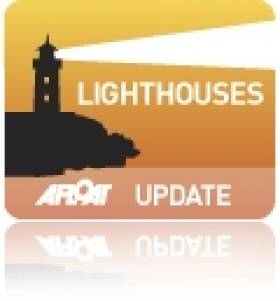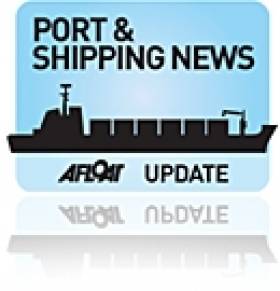Displaying items by tag: Irish Lighthouses
#NEW IRISH LIGHTHOUSE – The first lighthouse of a new generation to dot the Irish coastline was officially 'switched-on' at Roancarrigmore, a small island marking the eastern entrance to Castletownbere Co. Cork, writes Jehan Ashmore.
The ceremony was performed by Minister for Agriculture, Food and Marine, Simon Coveney, T.D. Constructed of stainless steel the new structure stands only 8.5m high and is sited at the foot of the original lighthouse that towers above, where there has a light since 1847 to warn shipping to the dangers of the rocky island.
The Commissioners of Irish Lights have taken an international lead in developing this new state of the art lighthouse, which beyond technical advances is also geared to make significant cost savings due to very low maintenance requirements.
In addition there will be environment benefits from the replacement of diesel generation by renewable energy and the ending of waste-water and refuse disposal.
The lighthouse has a low-voltage LED Light and provides a clearer quality of light and is far more reliable than traditional filament lamps. The new lighting system is powered using 12 x 50W solar panels to replace the masonry tower which had a 100 Volt, 1,500 Watt filament lamp and diesel generators.
The sectored light will be supplemented and monitored by Automatic Identification System (AIS) functionality which advises the mariner directly on their bridge of the status and position of the light.
AIS is a key component of the International Maritime Organisation e-Navigation project and will ensure Roancarrig is equipped to take advantage of this initiative.
In addition there are proposals to examine possible new uses for the older lighthouse which is adjoined by a former lighthouse-house keeper dwelling used by previous generations before automation took over.
Lecture: Dublin Bay and the Kish Light
#LECTURES – Pádraig Laffan will present his lecture on 'Dublin Bay and the Kish Light' next Tuesday (20th March) starting at 8pm in the Foxrock Parish Centre. The Co. Dublin venue is located at the rear of the R.C. Church.
All are welcome to the lecture (admission €3) which is part of a monthly held talks programme run by the Foxrock Local History Club. For further information visit www.foxrocklocalhistory.ie/page7.html
Tanker and Lifeboats Conduct Emergency Exercises off Dalkey Island
Crew kitted in similarly bright orange coloured sea safety-survival suits entered the lifeboat before it plunged into the water. The activity was observed through the binocular-scope which overlooks Coliemore Harbour with excellent views across the sound to Dalkey Island, Dublin Bay and Howth Peninsula.
The binocular-scope does not require payment to operate and was unveiled in 2008 in memory of local resident the late Dr. John de Courcy Ireland, the 'father' of maritime Ireland (to read more click HERE). He was for 26 years a honorary secretary of the local RNLI station in Dun Laoghaire and a staunch campaigner of Irish maritime affairs.
Each Monday a routine lifeboat practice is conducted by the 47ft Trent class ALB (all-weather lifeboat) RNLB Anna Livia (info and PHOTO). Last night's drill also involved the new D-class ILB (inshore lifeboat) RNLB Réalt na Mara which was named earlier this year by Kathy Kenny, wife of RTE presenter Pat Kenny.
Under the cover of darkness the crew of the ILB Realt na Mara simulated an 'injured casualty' on the island where the casualty was prepared to be taken off by stretcher from the island's small harbour. From there the casualty was transferred to the larger RNLB Anna Livia which lay offshore. During the exercise, powerful searchlight beams from the ALB provided essential light to assist in the transfer operation.
Asides the lifeboats, there is plenty of wildlife to observe on the rocky outcrops at Maiden Rock, Clare Rock and Lamb Island, which forms the second largest island after the main island of 22-acres, where a resident herd of goats have been part of the local community for over 200 years.
As for the South Korean built Cumbrian Fisher, she too has close connections with these waters as she was named in Dublin Port in 2005. She is a frequent caller to Dublin bringing bulk liquid products from the oil refinery in Milford Haven, Pembrokeshire which is a major supplier, serving the demands of the capital.
Dublin Port has two oil jetties which cater for four tankers, where bitumen, chemicals, liquid petroleum gases, molasses and oil are handled on a 41-hectare zone with storage for 330,000 product tonnes to include 6,000 tonnes of LPG. In addition aviation fuel is frequently delivered to the terminal to satisfy the constant demand for aircraft using Dublin Airport.
Cumbrian Fisher alongside her sister Clyde Fisher where built for James Fisher & Sons and in recent years they have tended to take anchorage off Dalkey Island and off the Nose of Howth. In comparison the vast majority of vessels anchor in Dublin Bay which is divided into quadrants for the purposes of anchorage allocation.
Before the completion of the South Wall in Dublin Port, which considerably improved safer access of vessels entering the River Liffey, it was the relative deeper and sheltered waters of Dalkey Sound which were used instead as Dalkey acted as the principle port for Dublin between 14-17th centuries.
Vessels would convey cargoes which were taken to and fro by lighter to the coast where it was carried by horse and cart to nearby Dalkey before onward travel across the exposed plains to Dublin City.
To learn more about Dalkey's medieval maritime heritage with its relationship with the capital of Dublin in addition the use of Dalkey Quarry in the construction of (Kingstown) Dun Laoghaire Harbour, visit the Dalkey Castle & Heritage Centre. To read more go to www.dalkeycastle.com in addition to further information about Dalkey including the local community council newsletters click HERE.
- Dublin Bay
- Dublin Airport
- Dublin Bay News
- Commissioners of Irish Lights
- Irish Lights
- coliemore harbour
- Pembrokeshire
- Dalkey Island
- Port of Dublin
- River Liffey
- Ports and Shipping News
- The Muglins
- Coastal Notes
- Howth Peninsula
- Pat Kenny
- Dalkey Sound
- Lighthouse news
- Irish Lighthouses
- Cumbrian Fisher
- Jas Fisher & Sons
- Clyde Fisher
- Milford Haven Oil Refinery
- Dalkey Castle & Heritage Centre
- Dr. Ireland
- Dr. John de Courcy Ireland
- Irish maritime historian
- Kingstown Harbour
- Kathy Kenny
- RTE presenter Pat Kenny
- South Wall Dublin Port
- Medieval Dalkey
- Dalkey Quarry
- Aviation fuel
- Dalkey Tidy Towns Committee
- Nose of Howth
- Dublin Port Oil Jetty Terminal
- Dalkey Community Council
- Dalkey Island Goats
Big Plans for Rosslare Europort
Ambitious plans to introduce load-on load-off (Lo-Lo) facilities at Rosslare Europort have been announced, according to a report in yesterday's Wexford People.
However, to facilitate all these developments, Mr Lynch said they will need the reclamation of up to 20 hectares of additional land and the deepening of part, or all, of the port from the current 7.2m to 9m and perhaps, eventually, 11m.
Mr Lynch said these developments would be facilitated, and accelerated, by of a port centric logistics zone (a grouping of activities dealing with freight transportation) on lands beside the south-eastern port.
Mr Breen said he recognises the 'fundamental and strategic importance of Rosslare Europort to the economic development of the county'.
The county manager said he will recommend that 'appropriate policies, objectives and development management standards are included in the draft plan to facilitate the development of the port', subject to the appropriate technical and environmental assessments.
As part of his submission, Mr Lynch also requested that the '1902 Lighthouse' at the port, which is recognised on the National Inventory of Architectural Services, not be included on the Record of Protected Structures.
Mr Breen said he would give further consideration as to whether it would be appropriate to de-list the lighthouse in advance of the draft plan.
Next month the port will host the annual Irish Ports Conference in the Ferrycarrig Hotel, Wexford on Friday 30 September.
- Rosslare Europort
- Ports and Shipping News
- Irish Rail
- Iarnrod Eireann
- Ferry news
- Rosslare Harbour
- Irish Ports Conference
- Irish Ports Association
- Ferrycarrig Hotel
- Railfreight
- Port Development
- National Inventory of Architectural Services
- Record of Protected Structures
- Irish Lighthouses
- Lighthouses of Ireland news


























